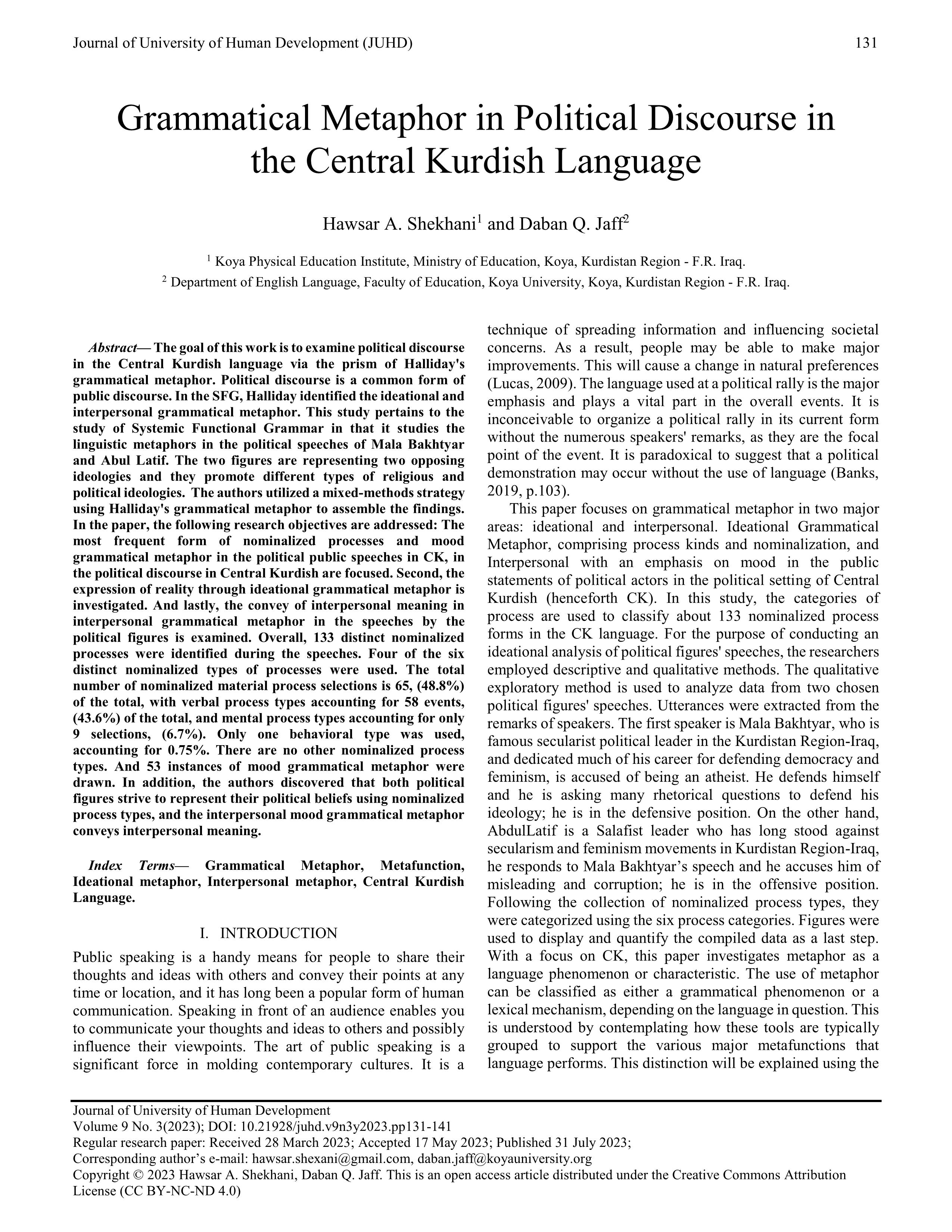Grammatical Metaphor in Political Discourse in the Central Kurdish Language
DOI:
https://doi.org/10.21928/juhd.v9n3y2023.pp131-141Keywords:
Grammatical Metaphor, Metafunction, Central Kurdish Language, Ideational metaphor, Interpersonal metaphorAbstract
The goal of this work is to examine political discourse in the Central Kurdish language via the prism of Halliday's grammatical metaphor. Political discourse is a common form of public discourse. In the SFG, Halliday identified the ideational and interpersonal grammatical metaphor. This study pertains to the study of Systemic Functional Grammar in that it studies the linguistic metaphors in the political speeches of Mala Bakhtyar and Abul Latif. The two figures are representing two opposing ideologies and they promote different types of religious and political ideologies. The authors utilized a mixed-methods strategy using Halliday's grammatical metaphor to assemble the findings. In the paper, the following research objectives are addressed: The most frequent form of nominalized processes and mood grammatical metaphor in the political public speeches in CK, in the political discourse in Central Kurdish are focused. Second, the expression of reality through ideational grammatical metaphor is investigated. And lastly, the convey of interpersonal meaning in interpersonal grammatical metaphor in the speeches by the political figures is examined. Overall, 133 distinct nominalized processes were identified during the speeches. Four of the six distinct nominalized types of processes were used. The total number of nominalized material process selections is 65, (48.8%) of the total, with verbal process types accounting for 58 events, (43.6%) of the total, and mental process types accounting for only 9 selections, (6.7%). Only one behavioral type was used, accounting for 0.75%. There are no other nominalized process types. And 53 instances of mood grammatical metaphor were drawn. In addition, the authors discovered that both political figures strive to represent their political beliefs using nominalized process types, and the interpersonal mood grammatical metaphor conveys interpersonal meaning.
References
Banks, D. (2019). A systemic functional grammar of English: a simple introduction. Routledge.
Byrnes, H. (2009). Emergent L2 German writing ability in a curricular context: A longitudinal study of grammatical metaphor. Linguistics and Education, 20(1), 50-66.
Caffarel, A. (2009). Systemic systematic functional grammar and the study of Meaning. In Oxford Handbooks Online. Oxford University Press. https://doi.org/10.1093/oxfordhb/9780199544004.013.0031
Derewianka, B. (1995). Language development in the transition from childhood to adolescence: The role of grammatical metaphor. Sydney, Australia: Macquarie University.
Derewianka, B. (2003). Grammatical metaphor in the transition to adolescence. Amsterdam Studies In the Theory and History of Linguistic Science Series 4, 185-220.
Eggins, S. (2011). An introduction to systemic functional linguistics (2nd ed.). Bloomsbury; Indiana University.
Gerot, L., & Wignell, P. (1994). Making sense of Functional Grammar. Cammeray, NSW: Antipodean Educational Enterprises.
Halliday, M. A. K. (1970). Functional Diversity in Language as Seen from a Consideration of Modality and Mood in English. Foundations of Language, 6(3), 322–361. https://philpapers.org/rec/HALFDI
Halliday, M. A. K. (2001). Literacy and Linguistics; Relationship between Spoken and Written Language. In A. Burns, & C. Coffin, Analysing English in a global context: a reader (pp. 181-193). New York, NY: Routledge.
Halliday, M. A. K., & Martin, J. R. (1993). Writing Science. Literacy and Discourse Power. Flamer press: London.
Halliday, M. A. K., & Matthiessen, C. (1994). An Introduction to Functional Grammar. (2nd ed.). Arnold; New York.
Halliday, M. A. K., & Matthiessen, C. M. (2013). Halliday's Introduction to Functional Grammar. Routledge: New York.
Heyvaert, L. (2003). Nominalization as grammatical metaphor. Grammatical metaphor: Views from systemic functional linguistics, 65-101. Amsterdam: John Benjamins Publishing
https://www.macrothink.org/journal/index.php/ijl/article/view/4192
Hybels, S., & Weaver, R. L. (1998). Communicating Effectively. Mcgraw-Hill Education, Cop.
Lucas, S. (2009). Student Workbook for the Art of Public Speaking. Mcgraw-Hill: New York.
Mathiessen, C. Halliday, M.A.K. (1997). Systemic functional grammar: A first step into the theory. Researchgate. Accessed Dec, 2022.
Ryshina-Pankova, M. (2015). A meaning-based approach to the study of complexity in L2 writing: The case of grammatical metaphor. Journal of Second Language Writing, 29, 51-63.
Shekhani, H. (2022). Halliday’s Interpersonal Meta-function Analysis of Entrepreneurs’ Public Speeches in English and Central Kurdish: A Comparative Study [Master Thesis]. https://www.researchgate.net/publication/366963608_Halliday's_Interpersonal_Meta-function_Analysis_of_Entrepreneurs'_Public_Speeches_in_English_and_Central_Kurdish_A_Comparative_Study
Simon-Vandenbergen, A.-M., Taverniers, M., & Ravelli, L. J. (2003). Grammatical metaphor: views from systemic functional linguistics. John Benjamins Publishing Company; Amsterdam.
Stone, D. A. (1989). Causal stories and the formation of policy agendas. Political Science Quarterly, 104(2), 281-300.
Taverniers, M. (2006). Grammatical metaphor and lexical metaphor: Different perspectives on semantic variation. Neophilologus, 90(2), 321-332.
Taverniers, M. (2017). Grammatical metaphor. In The Routledge Handbook of Systemic Functional Linguistics (pp. 378-396). Routledge: London.
Thompson, G. (2013). Introducing Functional Grammar. New York: Routledge.
Yan, F. (2005). System Function Grammar and Discourse Analysis. Foreign Language Teaching. New York: Routledge.
دزەیی، ع. م. (2014) رێزمانی کوردی. هەولێر :بڵاوکراوەی ناوەندی ئاودێر

Downloads
Published
How to Cite
Issue
Section
License
Copyright (c) 2023 Hawsar A. Shekhani, Daban Q. Jaff

This work is licensed under a Creative Commons Attribution-NonCommercial-NoDerivatives 4.0 International License.


